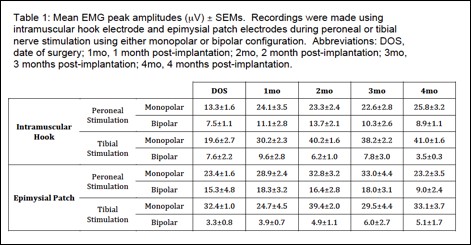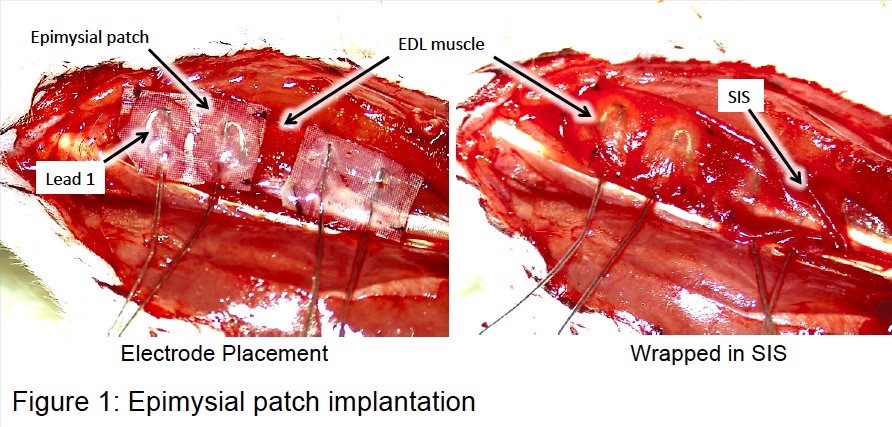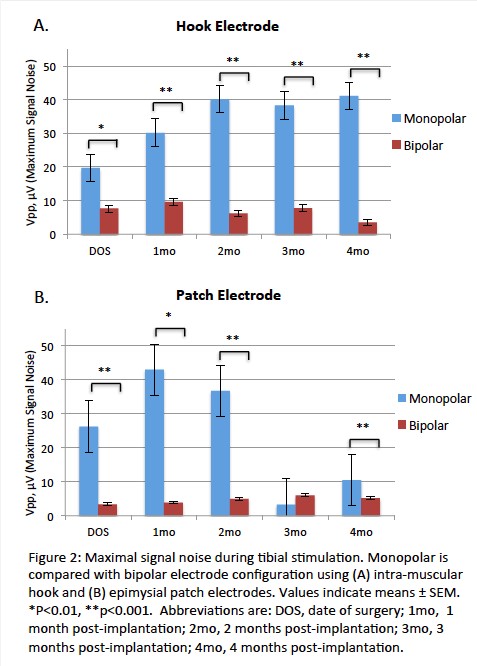Back to 2015 Annual Meeting Program
Comparing Epimysial Patch with Intramuscular Hook Electrodes for Electromyography Recording of Regenerative Peripheral Nerve Interfaces
Ian Sando, MD; Michelle Leach, PhD; Shoshana L. Woo, MD; Jana D. Moon, BS; Paul S. Cederna, MD, Nicholas B. Langhals, PhD; Melanie G. Urbanchek, PhD
Plastic Surgery, University of Michigan, Ann Arbor, MI
Purpose: Advanced motorized prostheses with multiple degrees of freedom have the potential to improve upper extremity amputee function, but reliable interface technology for volitional control is lacking. We developed a Regenerative Peripheral Nerve Interface (RPNI) consisting of a unit of free muscle neurotized by a transected peripheral nerve and an implanted epimysial electrode. RPNI biologic signals are capable of controlling myoelectric limbs by reliably transmitting electromyographic (EMG) signals, but the most appropriate electrode type and configuration has yet to be determined. We therefore compare epimysial patch electrodes with intramuscular hook electrodes using monopolar and bipolar configurations to determine which recording strategy transduces EMG signals with highest fidelity.
Methods: Using a rat model, two bipolar epimysial patch electrodes (n=4) (Figure 1) or two bipolar intramuscular hook electrodes (n=4) were applied to RPNIs of transferred extensor digitorum longus (EDL) muscle, neurotized by the divided peroneal nerve, and wrapped in small intestinal mucosa (SIS). Cables were tunneled subcutaneously to a head cap for recording. Twitch stimulation pulses were applied to either the peroneal (signal of interest) or tibial nerves (signal noise) and in vivo evoked EMG signals were recorded in monopolar and bipolar configurations. Data were collected at the time of electrode placement and at subsequent monthly intervals for four months.
Results: Recorded mean EMG peak amplitudes ± SEMs are listed in Table 1. Compared to monopolar recording strategy, a bipolar configuration decreased signal noise as determined by tibial nerve stimulation for both epimysial patch and intramuscular hook electrodes (p<0.01) (Figure 2). With peroneal nerve stimulation, the decrease in peak-to-peak EMG voltage was less (better) for patch electrodes when comparing monopolar to bipolar recording strategies. Intramuscular hook electrodes were more prone to failure as a result of cable breakage, migration, and extrusion.
Conclusion: Epimysial patch electrodes were superior to intramuscular hook electrodes with respect to maximizing signal amplitude, minimizing signal noise, and being less prone to failure in a rat model. Acknowledgment: This work was supported by DARPA (N66001-11-C-4190).



Back to 2015 Annual Meeting Program
